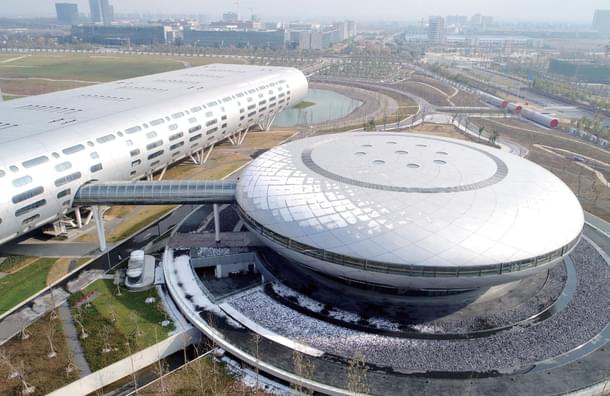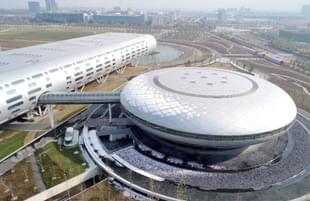Tech
Chip Wars: Commissioning Of TSMC Kumamoto Semiconductor Fab In Record Time Is A Big Win For Japan's Quest To Regain Chipmaking Glory
Swarajya Staff
Feb 26, 2024, 04:42 PM | Updated 06:59 PM IST
Save & read from anywhere!
Bookmark stories for easy access on any device or the Swarajya app.


TSMC (Taiwan Semiconductor Manufacturing Co), the world's leading chipmaker, on Sunday (Feb 25) inaugurated its new chip manufacturing unit in Kumamoto,Japan.
The Kumamoto fab is slated to begin mass production in the fourth quarter of this year.
The fab will be owned and operated by Japan Advanced Semiconductor Manufacturing, Inc. (JASM), a joint venture company between TSMC and Sony Semiconductor Solutions Corporation.
While TSMC holds the majority ownership (over 86%) in the JV, Sony is investing up to $500 million to have a 6% stake. Other partners include Denso Corp and Toyota Motor Corp, which joined the venture early this month.
The fab will initially provide foundry service with initial technology of 22/28-nanometer processes to address robust global market demand for speciality technologies.
JASM also announced that it will build a second fab in Kumamoto. The second fab would use cutting-edge 6-nanometer technology to produce advanced chips to meet the growing demand for artificial intelligence (AI) chips and those used in autonomous vehicles.
The Japanese government is offering an estimated $ 8 billion in subsidies for the two Kumamoto fabs.
Addressing the gathering via video message during the launch of the fab, Prime Minister Fumio Kishida announced that the Japanese government has decided to support the newly announced expansion of JASM.
"The production of advanced logic semiconductors at JASM is a significant step in both our country's semiconductor industry and user industries," PM Kishida.
Te overall investment in JASM is pegged at $20 billion. The fabs will roll out TSMC's mature 40-nanometer, 28-nanometer, 22-nanometer, 16-nanometer and 12-nanometer processes and the advanced 7-nanometer and 6-nanometer technologies.
During the inaugural ceremony, TSMC founder Morris Chang predicted a "chip renaissance" in Japan.
"This [new factory] will improve supply resiliency of chips for Japan and for the world," he said. "It will also, I believe, I hope, start a renaissance of semiconductors." Chang added
There was considerable scepticism when TSMC first unveiled its plan to build a new fabrication facility in Japan in 2022 and commence production in 2024. Some observers even dismissed it as an implausibly aggressive schedule.
TSMC attributed the speedy construction of its fab to support from "suppliers, customers, business partners, [Japanese] government and academia."
Incidentally, TSMC began working on its planned U.S. fab in Arizona about a year before the construction in Kumamoto was launched. However, the progress of the Arizona fab has been affected due to clashes with labour unions and delays in subsidy allocations. The planned facility is not expected to start commercial production before next year, so it is a year behind schedule.
Japan's Chip Ambitions
To build domestic self-sufficiency in the semiconductor supply chain, the Japanese Ministry of Economy, Trade and Industry (METI) unveiled an ambitious plan to attract the likes of TSMC, Samsung Electronics and Micron with billions of dollars in subsidies.
Japan will invest at least ¥1 trillion ($9 billion) toward chip development in a bid to revive its national industry.
Japan is pursuing an all-out strategy to lure overseas semiconductor companies, including designing generous financial incentives.
Japan lags behind South Korea and Taiwan in advanced chip manufacturing. It imports more than 60% of its semiconductors, much of them from Taiwan and China.
Chip manufacturers from Taiwan dominate the 10-nanometer (nm) chips that drive smartphones, and in South Korea, 28nm technology used in automobiles is mainly produced in Taiwan and China.
Local Japanese player Renesas Electronics can mass-produce only up to 40nm chips domestically.
Japan's share of global semiconductor sales plummeted to just 10% in 2019, down from 50% in 1988. The country still has 84 chip factories, the world's largest, but they need to produce more high-end products. As a result, Japan now has to import 64% of its semiconductors.
NEC, Toshiba and Hitachi were widely regarded as the pioneers in the semiconductor industry during the 1980s and 1990s. But, this began to change in the 2000s as chip design became uncoupled from manufacturing, leading to the rise of foundries like TSMC.





